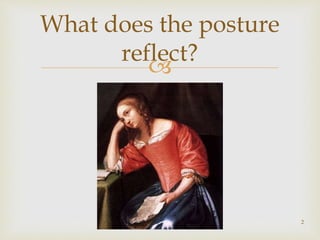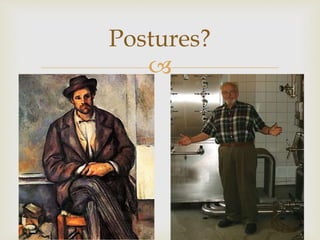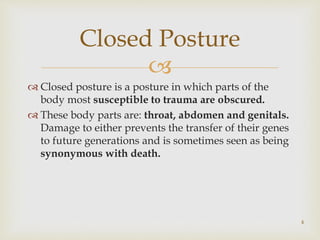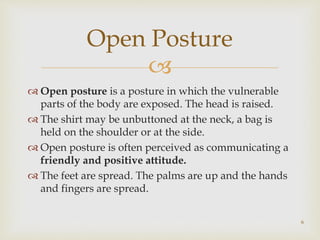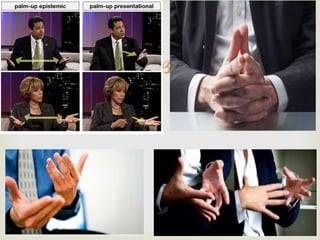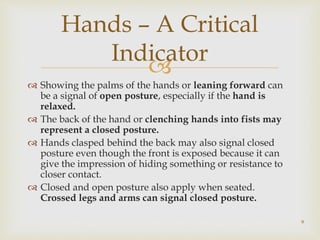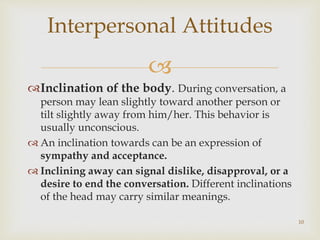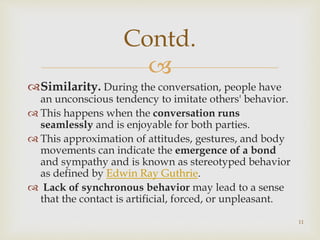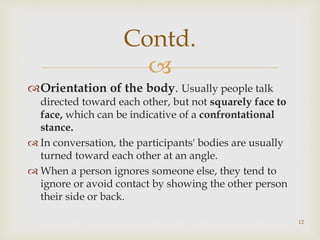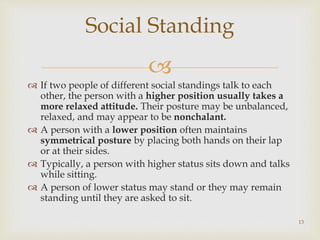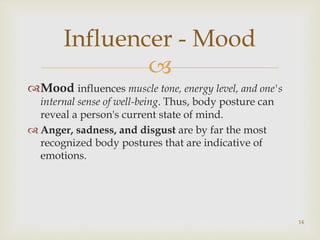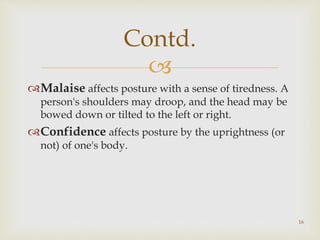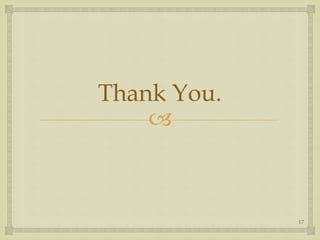Interpreting Body Language - Posture Behavior
- 1. - Mayank Bhardwaj Assistant Professor - Communication Skills 1
- 2. ď‚– What does the posture reflect? 2
- 4. ď‚– ď‚™ Closed posture is a posture in which parts of the body most susceptible to trauma are obscured. ď‚™ These body parts are: throat, abdomen and genitals. Damage to either prevents the transfer of their genes to future generations and is sometimes seen as being synonymous with death. Closed Posture 4
- 5. ď‚– ď‚™ Arms crossed on the chest or abdomen, ď‚™ Hands clasped in front of the genitals, and crossing legs. ď‚™ Clothing may also signal closed posture: a buttoned suit, or a handbag or briefcase held in front of the person. ď‚™ Closed posture often gives the impression of detachment, disinterest, and hostility. Research has also shown that these behaviors usually convey unpleasant feelings. Contd. 5
- 6. ď‚– ď‚™ Open posture is a posture in which the vulnerable parts of the body are exposed. The head is raised. ď‚™ The shirt may be unbuttoned at the neck, a bag is held on the shoulder or at the side. ď‚™ Open posture is often perceived as communicating a friendly and positive attitude. ď‚™ The feet are spread. The palms are up and the hands and fingers are spread. Open Posture 6
- 7. ď‚– 7
- 8. ď‚– 8
- 9.   Showing the palms of the hands or leaning forward can be a signal of open posture, especially if the hand is relaxed.  The back of the hand or clenching hands into fists may represent a closed posture.  Hands clasped behind the back may also signal closed posture even though the front is exposed because it can give the impression of hiding something or resistance to closer contact.  Closed and open posture also apply when seated. Crossed legs and arms can signal closed posture. Hands – A Critical Indicator 9
- 10. ď‚– ď‚™Inclination of the body. During conversation, a person may lean slightly toward another person or tilt slightly away from him/her. This behavior is usually unconscious. ď‚™ An inclination towards can be an expression of sympathy and acceptance. ď‚™ Inclining away can signal dislike, disapproval, or a desire to end the conversation. Different inclinations of the head may carry similar meanings. Interpersonal Attitudes 10
- 11. ď‚– ď‚™Similarity. During the conversation, people have an unconscious tendency to imitate others' behavior. ď‚™ This happens when the conversation runs seamlessly and is enjoyable for both parties. ď‚™ This approximation of attitudes, gestures, and body movements can indicate the emergence of a bond and sympathy and is known as stereotyped behavior as defined by Edwin Ray Guthrie. ď‚™ Lack of synchronous behavior may lead to a sense that the contact is artificial, forced, or unpleasant. Contd. 11
- 12. ď‚– ď‚™Orientation of the body. Usually people talk directed toward each other, but not squarely face to face, which can be indicative of a confrontational stance. ď‚™ In conversation, the participants' bodies are usually turned toward each other at an angle. ď‚™ When a person ignores someone else, they tend to ignore or avoid contact by showing the other person their side or back. Contd. 12
- 13. ď‚– ď‚™ If two people of different social standings talk to each other, the person with a higher position usually takes a more relaxed attitude. Their posture may be unbalanced, relaxed, and may appear to be nonchalant. ď‚™ A person with a lower position often maintains symmetrical posture by placing both hands on their lap or at their sides. ď‚™ Typically, a person with higher status sits down and talks while sitting. ď‚™ A person of lower status may stand or they may remain standing until they are asked to sit. Social Standing 13
- 14. ď‚– ď‚™Mood influences muscle tone, energy level, and one's internal sense of well-being. Thus, body posture can reveal a person's current state of mind. ď‚™ Anger, sadness, and disgust are by far the most recognized body postures that are indicative of emotions. Influencer - Mood 14
- 15. ď‚– ď‚™Stress can affect posture subconsciously; a person under stress will often have a greater amount of muscle tension, and may also have shallow breathing. ď‚™Well-being affects posture by giving it a sense of energy and balance. A person's spine will be straight and the head raised. Influencer - Wellbeing 15
- 16. ď‚– ď‚™Malaise affects posture with a sense of tiredness. A person's shoulders may droop, and the head may be bowed down or tilted to the left or right. ď‚™Confidence affects posture by the uprightness (or not) of one's body. Contd. 16
Editor's Notes
- #3: Slouched, forehead resting on palm – lost in thoughts possibly concerned about a problem mentioned in the letter or paper shown.
- #4: Closed posture – indicates what – closed thoughts and attitude towards the environment or the person specific present on-spot. Open posture – indicates what – open thought and positive attitude – open behaviour towards and a welcoming attitude to people.
- #5: Death here indicates that the person due to life threatening or image damaging reasons will be closed to others.

